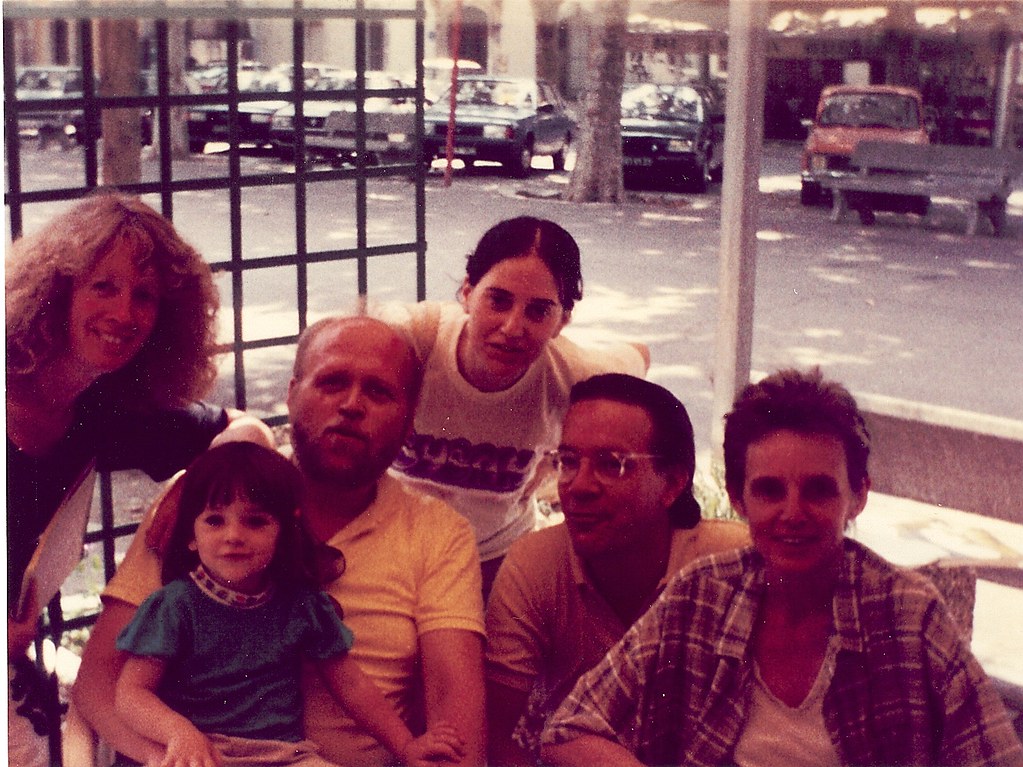L-R: Lyn Hejinian, Emma Bee Bernstein, RS,
Susan Bee, Bruce Andrews & Susan Howe,
One of the many pleasures of being in Atlanta Saturday for the marriage of my nephew, Daniel Silliman, to Beth Jarvis was getting to see my half-sister Nancy meet my brother Cliff for the first time ever. Our father, Glenn Sherman Silliman, died in 1965 at the age of 38 from burns suffered in an on-the-job explosion, having had three marriages & leaving behind shards of family everywhere he went. Forty-four years later, we’re still putting the pieces back together.
My father’s nickname was Lucky, which may seem macabre in retrospect, but if he had not walked away from an airplane crash in
Going to & from
But 46 of its 80 pages are the two interviews, and the volume as a whole is a page-turner as interviews so often can be. As the note from the Belladonna Collective makes clear, they had invited Bernstein to participate in their Elder Series on the strength of her presentation on a panel at the
The idea of “memorializes” takes on a very different meaning when it is the youngest participant who has died. It is now evident that this volume – at 80 pages quite a bit more than a chaplet – will be one of the three or four major planks of Emma Bee Bernstein’s life work, along with her photographs and the forthcoming girlDRIVE.
The two interviews within this book are quite different. The one with Susan Bee has a collaborative feel to it, which is not surprising, while the one with Marjorie Perloff is more confrontive. Neither Bee or Perloff is a feminist in the classic sense that Nona’s mother, Ellen Willis, was characterized by in the headline to her own obit in the New York Times. But Bee & Perloff both are successful women in the arts with few illusions as to what that entails. Perloff challenges the two young women right at the start of their interview:
Emma Bee Bernstein: When did you first come to identify as a feminist?
Marjorie Perloff: Actually, I’ve never particularly identified myself as a feminist, although I’ve always been a staunch advocate of equality between the sexes, equal pay for equal work, and so on…. I never identified with feminist writers’ groups or feminist professors because I have a great resistance to identity politics…. And I don’t really believe that there is such a thing as “feminist art,” once you get past the days of Judy Chicago protest art. Of course imagery, subject matter, style may well identify a particular artist as “female,” but there are always other things at play as well. It may be religion or nationality or ethnicity, or parental influence. Each of us is different.
The interview that follows from this is radically different from the one Perloff did with Hélène Aji and Antoine Cazé, the PDF of which I linked to March 12. Where Aji & Cazé seem awed by Perloff & content to confirm Perloff in whatever she says, Bernstein & Aronowitz challenge Perloff right back, and the ensuing give-and-take turns out to be one of the better discussions on this topic I’ve read. There is also a full-page (6.5”-by-7.5”) photograph of Perloff in her Pacific Palisades livingroom by Bernstein that is flat out the best portrait of Perloff I’ve seen. Indeed, it could be the best photograph ever of a major literary critic in situ. I would love to see it blown up large-scale to something Jeff Wall size.
One of the reasons Bernstein accomplished so much in such a short time was because she spent her entire life in the arts. Most artists & writers at 23 have been active in the arts for just a handful of years. Not Emma. Susan Bee writes:
Emma had relationships with the poets and artists that surrounded Charles and me. At age three, she was in the south of
This last comment points to what I think is this book’s secret sauce – empathy. Empathy is a formal element in Bernstein’s photographs, particularly in the staged tableaux, & very often what you see in them first. It’s an active constituent in the discussion with Perloff, and in every piece here, including Susan Bee’s essay, “Lost in Space,” titled after the collage on the volume’s cover but apt in a very different way for the unfamiliar role Susan now finds herself in as a mother responsible for preserving the artistic legacy of her daughter. It’s a substantial legacy for someone so young.






